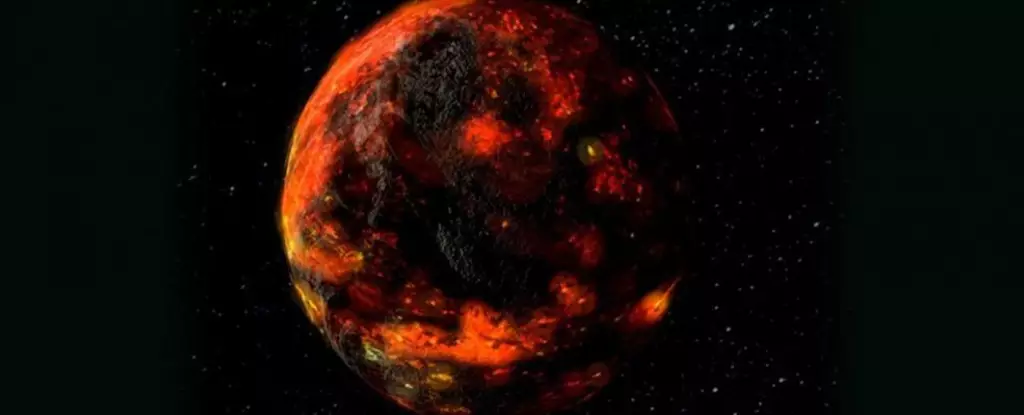The Moon, Earth’s steadfast companion, has long intrigued humanity with its enigmatic past. While significant strides have been made in understanding our closest natural satellite, a plethora of mysteries linger regarding its formation and development. Recent scientific endeavors have provided insights into the Moon’s early history, particularly focusing on the processes that resulted in its unique geological composition. A comprehensive analysis of lunar rock samples from the Apollo missions has revealed that the Moon solidified around 4.43 billion years ago—remarkably coinciding with the period when Earth began to become a hospitable environment for life.
The prevailing theory regarding the Moon’s formation centers on a colossal impact between the early Earth and a Mars-sized body known as Theia. This catastrophic event occurred approximately 60 million years post the birth of the Solar System, around 4.6 billion years ago. The impact ejected a substantial amount of debris into space, which gradually coalesced to form the Moon. Initially, the Moon was a molten mass, a swirling sphere of magma that began to cool over time.
As the surface temperature decreased, the molten material stratified into different layers, leading to the formation of a lunar magma ocean. This process marked a critical phase in lunar history, as nearly 99% of this ocean eventually solidified, leaving behind a remnant termed KREEP—an acronym for potassium, rare earth elements, and phosphorus. Scientists, including a team led by University of Chicago geologist Nicolas Dauphas, have been meticulously analyzing these KREEP reservoirs to glean insights into lunar history.
To reveal the intricacies of the Moon’s history, scientists have harnessed the power of modern analytical techniques to study the compositions of lunar rock samples obtained during the Apollo missions. By examining varying proportions of elements, particularly lutetium and hafnium, researchers can deduce the age of lunar rock formations and their developmental timeline.
Lutetium, a rare earth element, decays over time into hafnium, and this decay process provides a chronological framework for understanding the sequence of geological events on the Moon. Researchers found that the KREEP formed approximately 140 million years after the Solar System’s genesis, resulting in a solidification timeline of about 4.43 billion years ago. The comparative analysis between lunar rocks and meteorites—other ancient celestial bodies—has allowed scientists to refine their chronological models, illuminating the Moon’s cooling process much more clearly than previous theories allowed.
The KREEP reservoirs are of particular interest not only because they symbolize a unique chapter in the Moon’s development but also due to the implications they hold for our understanding of lunar geography. Analysis of KREEP samples suggests a uniform distribution across the lunar surface, which could be validated through upcoming explorations of the South Pole-Aitken basin, the target for NASA’s Artemis missions.
Unraveling the distribution of KREEP will further illuminate the Moon’s geological history and provide vital clues about its thermal evolution. As scientists continue to probe the lunar surface for additional samples, the data collected will complement existing research and contribute to a more comprehensive understanding of the Moon’s early epochs.
The study of the Moon’s history does not solely serve to satisfy our curiosity about an extraterrestrial body; it bears profound implications for our understanding of Earth’s own evolution. Given that the colossal collision that birthed the Moon likely marked the last significant impact on Earth, this event can be seen as a turning point in Earth’s transformation into a stable and life-sustaining world.
As we further uncover the timeline of lunar cooling and the subsequent development of mare basalts—lava flows generated from impacts—we gather valuable insights applicable to Earth’s geological history. Understanding this event contributes to our knowledge of planetary evolution as a whole and the origins of conditions conducive to life.
The pursuit of knowledge regarding the Moon’s early history is far from over. Upcoming missions, including NASA’s Artemis and China’s Chang’e, promise to enhance our understanding of the lunar surface and its geological processes. The research conducted by Dauphas and his team represents a significant milestone in deciphering the Moon’s past, but it is merely a precursor to the wealth of information that awaits us from forthcoming lunar explorations. This ongoing journey to unravel the Moon’s ancient history reminds us of the interconnected nature of planetary systems and the shared stories written in the rocks of our celestial neighbors.


Leave a Reply